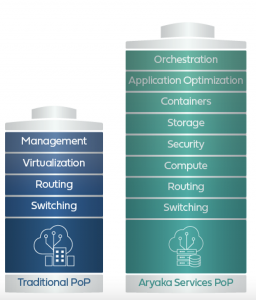To sign up for our daily email newsletter, CLICK HERE
A PoP stands for a Point of presence. It is a generic industry term to describe a demarcation point or physical location where two or more networks share a connection. PoPs are used by communication service providers, Internet Service Providers, Content Delivery Network providers, SaaS / IaaS providers, and SD-WAN providers.
A PoP can be as simple as a single server or as complex as a stack of routers, switches, servers, security gateways, and cloud gateways. Internet exchange points are Popular physical locations to host PoPs. These are locations where various entities like telecos, Internet Service Providers, Managed SD-WAN Services, and cloud service providers collocate equipment, making interconnection simpler, faster, and devoid of latency issues.
Are PoPs Needed for SD-WAN?
In a point of presence based SD-WAN architecture, the SD-WAN CPE at the customer’s site connects to the closest PoP rather than the datacenter directly. This architecture is the best of both worlds. The CPE performs functions like real-time traffic routing, selecting the appropriate transport, etc. while the PoP provides low latency jitter-free access to the HQ and off-ramps to cloud service providers. This solution is ideal for heavy users of cloud services and for ones who need multi-cloud connectivity.
The PoPs are distributed at strategic locations worldwide. Thus, connecting to a cloud service provider is through the shortest path rather than through the company’s data center.
SD-WAN Layer 3 PoPs vs. Layer 2 PoPs
There are different kinds of SD-WAN point of presence solutions. In these solutions, the service provider deploys PoPs distributed close to major business centers. These global PoPs are interconnected, typically using Layer 2 or Layer 3 networks. The choice of Layer 2 or Layer 3 is a critical one.
While Layer 3 interconnections are cheaper and faster to implement, they are not as reliable as Layer 2 interconnections. Vendors like Aryaka realize this distinction and have built their network of Layer 2 PoPs near the world’s foremost business centers. Aryaka’s private Layer 2 core infrastructure allows it to deliver on global SLAs for latency, jitter, and packet loss. Few other SD-WAN services can deliver this performance.
A Layer 3 based point of presence architecture may become inconsistent with jitter, latency, and packet loss. These factors are critical for real-time communications. For voice and video quality to remain high, the latency has to be below 150ms, and jitter can have a negative effect on the audio codecs. Aryaka’s Layer 2 interconnection between PoPs allows it to deliver very low latency and almost zero jitter.

Figure 1 provides a list of the capabilities contained in an Aryaka Services PoP.
Traditional SD-WAN PoP vs. a Services PoP
Traditional PoPs implement the onramp to the ISP providing local internet connectivity. Aryaka’s PoP provides advanced services including first-mile, middle-mile, and last-mile optimization, protocol acceleration, application optimization, and optimal peering to cloud services. It is so much more than a regular point of presence and is, therefore, called Po Services PoP.
Summary
SD-WAN solutions come in many flavors, with PoPs and without, each with its advantages and disadvantages. Even within the PoP based architecture, there are nuances like Layer 2 or Layer 3 PoPs or a traditional PoP vs. a Services PoP. These architectural differences have a significant effect, especially on cloud application performance, real-time UCaaS applications, and multi-cloud connectivity.